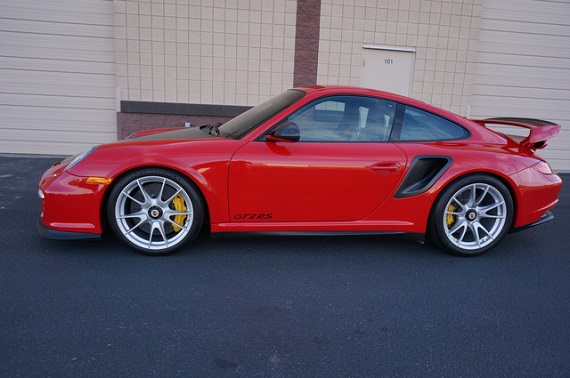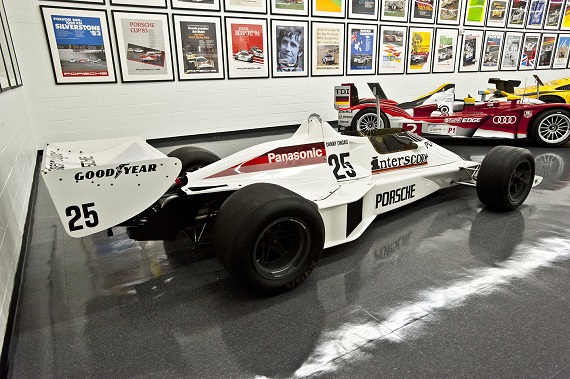I’m fairly certain this will be the least expensive of this group of cars I hope to feature, but that should not detract from our wonder and desire. It also may be the baddest 911 of them all. The Porsche 911 GT2 RS delights in excess. Gone are most of the luxuries familiar to owners of the 911 Turbo. Also gone is the confidence inspiring all-wheel drive system Porsche first made standard on the Turbo with the 993. In the place of those features is more power. However, those statements simply apply to the 911 GT2; an already mad car that pushed the bounds of what is possible in a rear-engine rear-drive machine. The RS provides a combination of both more and less. More power, less weight. For the GT2 RS that means 620 hp flying towards the rear wheels. And there’s no fancy transmission to allow the driver to keep both hands firmly gripping the wheel for perfect shifting every time. On top of all of that power is a 100 pound weight savings over the regular GT2 – adding up to a 400 pound weight savings over the already exhilarating 911 Turbo S. Like with any RS, the GT2 RS is focused and track inspired with performance that is almost incomprehensible on the street and certain not fully exploitable. If Porsche produced this model as an exercise of sorts, something to test their limits, it made quite the impression.
Tag: Motorsports Monday
One of the things I love the most about Audi is that for some time they liked to do things differently. Now, if you’re Porsche and you’re able to build a reputation around that insistence to do things differently through racing, then you can be a successful company. As such, the closely linked cousin Audi was taken racing by some of the same team from Porsche. The first big attempt in the 1980s was the push to win the World Rally Championship with their new Quattro model. Highlighting turbocharged technology coupled with a semi-revolutionary all-wheel drive system, the Quattro was a positive sensation until the mid-1980s and the death of Group B. Audi then took on Group A with the non-turbo Coupe quattro briefly, and also enjoyed some unlikely success rallying with their 200 sedan. But even success in World Rally Championship events wasn’t enough of a reputation boost for what lay ahead of Audi next, as 60 Minutes highhandedly nearly took the company right out of the marketplace. In order to rebuild the reputation of the company in the U.S., Quattro guru Jo Hoppen convinced Audi to go racing in the SCCA Trans-Am series. Headlining that series were tube-frame V8 behemoths that outwardly laughed as a production based luxury sedan with a measly 2.1 turbocharged inline-5 hanging way out the front pulled up to grid. It turned out they didn’t laugh too long:
CLICK FOR DETAILS: 1988 Audi 200 quattro Trans Am at Auto Collections
2 CommentsMost younger readers won’t immediately think any of the German marques were well established in single seaters prior to recent Mercedes-Benz domination in Formula 1. And to be fair, as individual manufacturers that is nearly the case, although Porsche did develop a pretty impressive single race winner in the flat-8 804 of 1962. And, let’s not forget that it was both Mercedes-Benz and Auto Union that had really spurred the development of modern single-seat racing in the pre-War Silver Arrows. But far more prevalent has been German participation in single-seater construction as engine providers. From Volkswagen’s spec racers right through the mighty screaming Williams BMW V10s, there’s a long and storied history of German power. But oval racing? That’s another story, right? Well, actually the Germans have been there right along, too – with Mercedes-Benz taking part in the inaugural Indy 500 through the mega-dominant Ilmore Penske PC-23. Porsche, too, has been tied with the Indy 500, running turbocharged V8s in March chassis in the late 1980s. But the more interesting story was the car that never ran – the 935-powered Parnelli/Interscope Racing entry from 1980:
CLICK FOR DETAILS: 1980 Parnelli/Interscope Porsche Indy Car on eBay
Comments closedOver the weekend I took advantage of some frankly great streaming video from the IMSA Racing application to view some of the Rolex 24 at Daytona. And the action was thrilling, with several classes being decided not in the last hour, but in the last minutes. Of particular interest to me was the GTLM category, where Porsche had been going round after round with team Corvette over the past few years. And while they weren’t challenging for the overall victory, it gave me pause to consider Porsche’s contribution to racing. You see, Porsche has recorded 22 overall victories at Daytona, but what’s perhaps more impressive is the claimed 77 class victories they’ve claimed. It wasn’t to be this year, but one of the 991 RSRs did make it to the podium. Fitting, then, that we should look at one of the more impressive and expensive variants of the 911 RSR; the 993 Cup 3.8. Only 30 of these racing variants were produced; less even than the road-going 3.8 Carrera RS with which it shared its name. Lightened, widened and with something like 400 horsepower coming from the race-prepared motor, these are still seriously potent track weapons today some 20 years later:
CLICK FOR DETAILS: 1995 Porsche 911 Carrera Cup 3.8 RSR on Race Cars Direct
Comments closedThe number of Porsche 911 variants can be baffling. Just the other day, Rob and I were joking back and forth that at one point a few years ago, Porsche offered no less than 20 variations of the 911 model to the public. Not to be outdone, the current lineup has added one more and created a nice drinking game of “How many current 911 models could you name?” Add in the racing variants, and things get even more convoluted. Porsche’s top of the heap racing model has always varied, but when it came to the 996 Porsche went full-bore with the 911 GT3 Cup program and created a potent race car for pros and well-to-do amateurs as well. Indeed, the GT3 Cup program was the model for many customer-based race programs that exist in Audi, Lamborghini, Aston Martin, Ferrari and the like today. But the lineage of the GT3 gets confusing, too. Launched in 1998, it was effectively a replacement for the 993 Carrera Cup model. Called the GT3 Cup, it was a stripped out factory built race car with a turned up motor and some trick suspension and wheels, along with a little added aero tweaks that would be the basis for the later road going model named after it – the 911 GT3. Confused? Well, in 1999 Porsche dropped the “Cup” from the name and added “R” to make race models distinct from road going models. Now, that’s easier. Then, they brought the GT3 Cup model back in 2000 with some mild performance upgrades. But things really started to get messy in 2001, when the company launched the GT3 RS model – not to be confused with the GT3 RS road going model, which wasn’t launched until 2003. Still with me? Well, then in 2004 they needed to differentiate the road and race GT3 RS, so with some more upgrades was launched the GT3 RSR. On the way from Cup to RSR, Porsche added more downforce, wider flares and more vents, along with more power and even wider tires. The 2001 RS model struck a balance between the Cup and RSR, with wider rear track and flared front fenders, but without the massive venting and sequential gearbox of the later model:









